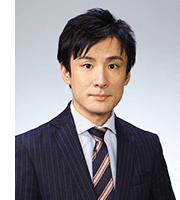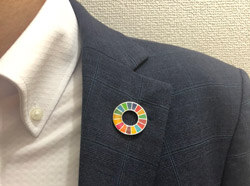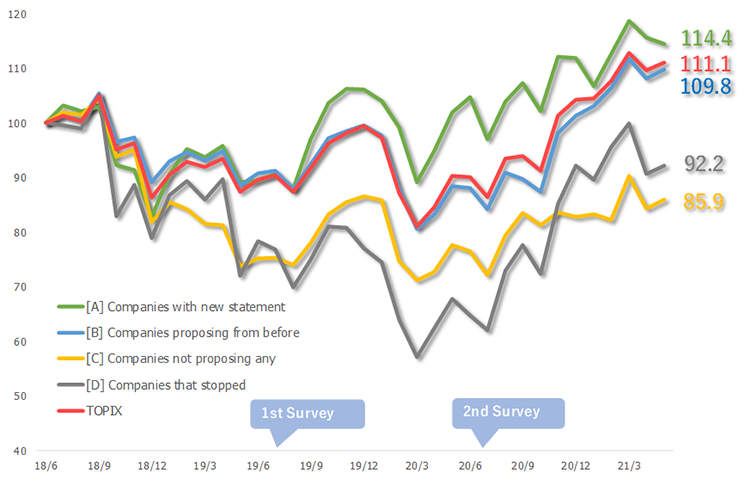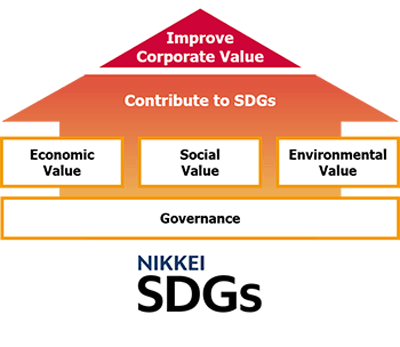SDGs Management: Are Top Executive’s Statement Really Effective?
Nikkei Research has been conducting various surveys to evaluate the efforts related to SDGs of companies and local governments. Such as the Nikkei SDGs Management Survey and the nationwide Cities & Counties SDGs Advancement Survey, to name a few. We will introduce what outcomes can be obtained by SDGs management and advanced case studies toward combating climate change and achieving carbon-zero, which has become an urgent issue nowadays.
In this article, we will focus on the effects of statements sent out by top executives of companies.
*******************************

Takashi Omori

more common. (Sold at UN Shop, 10 for $35)
On the other hand, the problem of "SDG-washing", where businesses pointing out how they align and take actions regarding the SDGs but not really making a meaningful contribution to it, has risen. Such companies that are seen as “SDG-washing” would lose their trust. We analyzed the data of the Nikkei SDGs Management Survey to see whether companies with top executives giving out messages on SDGs have an advanced SDGs management status.
Significant progress in SDGs management in companies with top executives’ new statements
The SDGs Management Survey started in 2019. Conducting annually, 2021 marks the 3rd time. The survey evaluates companies' efforts in the areas of "economic value", "environmental value", "social value", and "governance" as an overall deviation score.
To see the difference in the promotion of SDGs management between companies with top executives stating their contribution to the SDGs and not, we divided the companies into 4 groups -- [A] companies that proposed a new statement on SDGs (that have not been sent out in 2019) from the top executives in 2020, [B] companies that have been proposing statements on SDGs before/since 2019, [C] companies that are not proposing any statement in 2019 or 2020, [D] companies that proposed a statement in 2019 but not in 2020 -- and compared their overall deviation scores.
The overall deviation score between 2019 and 2020 increased the most in group A "companies with new statement” (Table 1). While most of the companies are accelerating their SDGs efforts, the relative 2.3-point increase in the overall deviation score is a significant positive change. The result which group A showed a larger increase than that of group B "companies proposing from before", suggests that the top executive’s statement has a great effect on the organization and shifts them to push forward their SDG management. Moreover, having group D "companies that stopped", to show the most significant decrease, suggests that statements from the top executives is critical for promoting SDGs management.
Table 1. Status of statements and the change in SDGs Management Survey’s overall deviation score
| Top executive statements on SDGs | Status of statements | Change of overall deviation score | |
|---|---|---|---|
| 2019 | 2020 | ||
| [A] Companies with new statement | × | ○ | ▲+2.3 |
| [B] Companies proposing from before | ○ | ○ | ▲+0.8 |
| [C] Companies not proposing any | × | × | ▼-0.3 |
| [D] Companies that stopped | ○ | × | ▼-1.0 |
The stock market responded favorably to top executives’ statements.
Companies with a new statement surpasses the performance of TOPIX.
Next, we analyzed how investors perceive the top executives’ statements on SDGs.
The market capitalization over the past three years (with the end of June 2018 as 100, value as of the end of May 2021), group A “companies with new statement” scored 114.4, group B “companies proposing from before” at 109.8, group C “companies not proposing any” at 85.9, and group D “companies that stopped” at 92.2 (Figure 1).
Group A exceeded the performance of TOPIX (Tokyo Stock Price Index) which was at 111.1, indicating the companies within this group is highly valued in the stock market. It can be said that the expectations towards the acceleration on SDGs management and improving corporate value derived by the top executives’ statements led to the rise of market capitalization. On the other hand, although the market capitalization of group D fell sharply during the pandemic, they showed a stronger resilience than others.
In general, investors do not make investment decisions based only on companies’ responses to SDGs. However, as of the time of the survey in 2020, there was a wide gap in market capitalization between those who proposed a statement (group A and B) and those who did not (group C and D), indicating that proposing statements have a positive effect on investors' investment behavior.

*Based on 464 companies that responded to both surveys, 2019 and 2020.
From the results of two analyses, it was revealed that the top executives’ statement on SDGs is an effective way of promoting SDGs management and appealing to investors. Especially, the fact of sending out new statements having greater impact than continuous unchanged status, is a remarkably interesting insight. This suggests that companies should not leave their statements once it’s been out, but by updating it in response to the world changes, they can make it as a trigger to induce positive impact both internally and externally.
*******************************
The SDGs Management Survey consists of four pillars: "SDGs Strategy & Economic Value", "Environmental Value", "Social Value", and "Governance". Companies that link management and SDGs and improve their corporate value would be rated high.

| High-level categories | Mid-level categories |
|---|---|
| SDGs Strategy & Economic Value |
Policy on SDGs |
| Reporting and communication | |
| Promoting bodies / Internal systems | |
| Contribution to business | |
| Business performance | |
| Environmental Value | Environmental policy |
| Greenhouse gases | |
| Power consumption | |
| Waste | |
| Water resources | |
| Climate change, resources, and biodiversity | |
| Initiatives for carbon-free | |
| Social Value | Respect for human rights |
| Measures on consumer issues | |
| Measures on social issues | |
| Working hours and leaves | |
| Diversity | |
| Governance | Corporate governance policy |
| Board of directors, nomination/compensation committee | |
| Executive compensation | |
| Separation of executive and supervisory functions | |
| Effectiveness and continuity of governance |
Under the mid-level categories, there are more detailed low-level categories for each respectively, such as "communication by top executives", "disclosure of climate change related risks/opportunities", "respect for human rights in the supply chain", and "disclosure of board skills matrix”.
-
Feb/14/2022
please contact us below.

